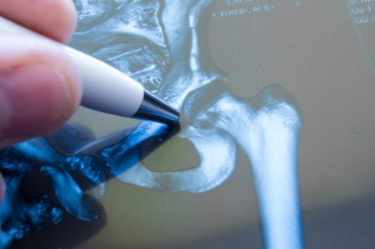If you enjoy an active lifestyle, keeping your hip joints healthy is extremely important. The hips support the weight of the body and are also responsible for movement of the upper legs. Given their importance to mobility, in the event of damage, some patients seek to solve the problem through surgery. This article aims to explore the subject of artificial hips and ask: what are hip replacements made of?

What is an artificial hip joint?
First things first, a hip joint consists of two main parts:
- a ball (or femoral head). This is found at the top of the thigh bone
- the femoral head fits into a rounded socket, sometimes referred to as the cup or acetabulum.
An artificial joint is a structure designed to replace the movements and role of the original hip joint. It is usually made from a combination of metal, plastic and/or ceramic. The makeup of the joint is generally quite straightforward. Metal components replace the original ball and socket joints of the hip.
During hip replacement surgery, the surgeon removes the damaged parts of the hip joint and replaces them with artificial equivalents. If you suspect you’re experiencing the signs of needing a hip replacement, please don’t hesitate to get in touch.
What holds the artificial hip joint in place?
An artificial hip joint can be cemented or uncemented. Uncemented joints are attached with a porous surface. This allows bone to grow over time and hold the joint in place.
For cemented joints, bone cement (or Polymethyl methacrylate) is traditionally used to help the implant remain in place.
What are hip replacements made of in the UK?
Artificial hip implants are typically made from a combination of the following materials:
- metal (titanium or cobalt)
- ceramic
- plastic (Polyethylene)
Types of hip replacement materials
The main types of hip replacement materials are:
- Metal-on-plastic – This metal-on-polyethylene implant is the most common type. The femoral head is made of metal while the socket is made of plastic (polyethylene). The metal components are most commonly made from cobalt-chromium, titanium, zirconium, or nickel. The main advantage of metal-on-plastic implants is that they’re the easiest to make. They also boast a long life span. Whereas advances in technology have reduced the risk, one of the disadvantages involves the potential for an immune reaction
- Ceramic-on-plastic – In this ceramic-on-polyethylene implant, the femoral head is made of ceramic and the socket is made of polyethylene. This type of implant is aimed at people who show sensitivity to metal implant components. As with the metal on plastic implant, this structure can also cause an immune reaction from particles used in the plastic piece. Ceramic-on-plastic implants are also designed for younger patients. This is because their durability makes them more suitable to patients with a more active lifestyle
- Ceramic-on-ceramic – With this implant, the ball is made of ceramic and the socket has a ceramic lining. The advantage of this material is it is much less likely to react with the body. On the downside, ceramic joints have been known to make a squeaking noise when the patient is mobile. They have also been known to shatter.
Metal implants
Cobalt-chrome is the most commonly used metal for hip implants. Titanium is also used but is a softer metal with similar properties to bone. While stainless steel has been used in the past, nowadays it is only used to repair fractured hips. This is because it’s too soft to be used as the primary metal of an implant.
In the event a patient has a metal allergy, the implant is coated in Zirconium to keep the metal from interacting with the patient’s blood.
Plastic implants
You cannot have an implant that’s fully made from plastic; all hip implants are a combination of materials. Of all the available plastic parts involved in total hip replacement, plastic polyethylene is the most important and widely used.
While polyethylene was one of the most common causes of hip revision surgery, technological advances over the past three decades have meant the risks of the plastic wearing have greatly reduced.
Ceramic hip replacement material
Ceramic is often used for the head and liner components because they’re less likely to wear out over time and are scratch-resistant. However, one of the disadvantages of ceramic is that it’s brittle and has the potential to shatter.
What is the most common hip replacement material?
The most commonly used material for hip implants is the metal-on-plastic combination. A closer look reveals that cobalt-chromium is the most frequently used metal. This is because it’s biocompatible and doesn’t corrode in the body. Polyethylene is preferred over other plastic options.
Types of implants available at Practice Plus Group
At Practice Plus Group, we offer combinations of all the implants types mentioned above. During surgery, your implant can be fitted with or without bone cement, depending on the recommendations of the surgeon. Among other factors, the type of implant you receive will depend on your age, level of fitness and your surgeon’s recommendation.
What is the best hip replacement material?
While it may sound like we’re avoiding giving a definitive answer, the truth is that it depends entirely on individual circumstances. And there are quite a few of these circumstances that you and your consultant will need to consider before making a decision.
Factors to consider when choosing the best joint replacement for you
Before you choose the type of implant you’re going to have, it’s a good idea to explore the benefits and risks of hip replacement surgery. There are a number of different factors that play a part into the type of implant your surgeon will recommend:
- Age – Generally, younger patients will require stronger implant materials. This is because they are more likely to have higher activity levels than older patients.
- Activity levels – If you’re an active person, you should consider whether you wish to maintain a similar level of physical fitness following your operation. This will inform your consultant’s decision when choosing the best implant material for you.
- Abnormalities – Any abnormalities should be brought to your consultant’s attention before hip surgery. This will allow him or her to make the necessary adjustments.
- Allergies – As with abnormalities, any relevant allergies should be brought to your consultant’s attention. For example, allergies to certain metals will shape your consultant’s final decision on implant material.
- Longevity – This is closely linked with a patient’s age. Hip implants typically last between 10 – 15 years, so patients aged around 50 will likely require a much more durable material than a patient aged in their 80s.
- Costs – While different implant materials are more expensive than others, hip replacement surgery at Practice Plus Group starts from £12,549. This price differs by location rather than type of implant material.
What is the longest-lasting hip replacement?
Longevity is one of the most important factors to consider if you need a hip replacement. The implant itself can be made from a range of different materials, which in turn can be combined to great effect. Each material has pros and cons, and some are more likely to last longer than others. Speak to your consultant for more information on which type of implant material is best for you.
Hip replacement material costs
While it’s difficult to pinpoint the exact costs of the different materials for total hip replacements, it is possible to compare them.
Ceramic implants are the most expensive to make of all the available options. However, they have the benefit of being both the longest-lasting and completely scratch resistant.
The most expensive metal component is when they’re coated in Zirconium. This happens when the patient suffers from a pre-existing allergy to metals.
While you cannot choose to have an artificial implant made solely of plastic, the plastic parts can be combined with ceramic or metal. Metal-on-plastic implants are the most common of all available options.
It should be noted that, while implants may differ in terms of materials used, the price to the customer will remain fixed.
New hip replacement technology
When talking about the future of hip or knee replacements, the most prominent technology on the horizon is robot-assisted surgery. While this is more advanced in the field of knee replacement implants, it is expected to play a bigger role in hip replacements once it is backed by a proven track record of success.
Hip replacement FAQs
Not quite found the information you’re looking for? Our hip implant FAQs might be able to help!
It’s less likely nowadays but does still happen as the majority of hip and knee implants contain metal in some quantity. However, over the years security machines have become smarter, while there is less magnetic metal used in the implants themselves. In the event your hip implant does set off a metal detector, we cannot be held responsible for the level of enthusiasm displayed by security teams!
As steel isn’t used at all as a material for hip replacements, titanium is definitively the better option for patients.
Cases of patient’s bodies rejecting metal implants are very rare. All components used are biocompatible but there’s always a small chance that a patient will develop a reaction.
Among the symptoms are skin rash, itching and discoloration of the skin in the area around the affected hip.






